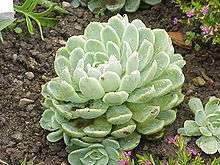Echeveria
| Echeveria | |
|---|---|
 | |
| Echeveria elegans | |
| Scientific classification | |
| Kingdom: | Plantae |
| (unranked): | Angiosperms |
| (unranked): | Eudicots |
| (unranked): | Core eudicots |
| Order: | Saxifragales |
| Family: | Crassulaceae |
| Subfamily: | Sedoideae |
| Tribe: | Sedeae |
| Subtribe: | Sedinae |
| Genus: | Echeveria DC.[1] |
| Species | |
|
See text. | |
| Synonyms | |
|
Courantia Lem. | |
Echeveria is a large genus of flowering plants in the Crassulaceae family, native to semi-desert areas of Central America, Mexico and northwestern South America. The genus is named after the 18th century Mexican botanical artist Atanasio Echeverría y Godoy.
Description
Plants may be evergreen or deciduous. Flowers on short stalks (cymes) arise from compact rosettes of succulent fleshy, often brightly coloured leaves.[2] Species are polycarpic, meaning that they may flower and set seed many times over the course of their lifetimes. Often numerous offsets are produced, and are commonly known as "hen and chicks", which can also refer to other genera, such as Sempervivum, that are significantly different from Echeveria.
Cultivation
Many Echeveria species are popular as ornamental garden plants. They are drought-resistant, although they do better with regular deep watering and fertilizing. Most will tolerate shade and some frost, although hybrids tend to be less tolerant. Most lose their lower leaves in winter; as a result, after a few years, the plants lose their attractive, compact appearance and need to be re-rooted or propagated. In addition, if not removed, the shed leaves may decay, harboring fungus that can then infect the plant.
Propagation
They can be propagated easily by separating offsets, but also by leaf cuttings, and by seed if they are not hybrids.
Selected species
|
|
Cultivars and Hybrids
Echeveria has been extensively bred and hybridised. The following is a selection of available plants.
|
|
|
"Perle von Nürnberg"[5] has gained the Royal Horticultural Society's Award of Garden Merit.
 Flowers of Echeveria "Blue Curl"
Flowers of Echeveria "Blue Curl" Echeveria cv. "Black Prince"
Echeveria cv. "Black Prince"
Formerly in Echeveria
- Dudleya anthonyi (as E. anthonyi)
- Dudleya arizonica Rose (as E. arizonica (Rose) Kearney & Peebles)
- Dudleya attenuata (as E. attenuata and E. edulis var. attenuata)
- Dudleya caespitosa (as E. californica, E. cotyledon, E. helleri, and E. laxa)
- Dudleya candida (as E. candida)
- Dudleya cultrata (as E. cultrata)
- Dudleya cymosa (Lem.) Britton & Rose (as E. cymosa Lem.)
- Dudleya edulis (as E. edulis)
- Dudleya pulverulenta ssp. pulverulenta (as E. argentea and E. pulverulenta)
- Dudleya saxosa ssp. collomiae (as E. collomiae)
- Graptopetalum paraguayense (N.E.Br.) E.Walther (as E. weinbergii hort. ex T.B.Sheph.)
- Pachyveria clavifolia (as E. clavifolia)[4]
Photo Gallery
 E. pulvinata flowers
E. pulvinata flowers- Echeveria Secunda var. Glauca in the UBC Botanical Garden
References
- 1 2 "Genus: Echeveria DC.". Germplasm Resources Information Network. United States Department of Agriculture. 2003-06-13. Retrieved 2011-10-21.
- ↑ RHS A-Z encyclopedia of garden plants. United Kingdom: Dorling Kindersley. 2008. p. 1136. ISBN 1405332964.
- ↑ "Echeveria". Integrated Taxonomic Information System. Retrieved 2011-10-21.
- 1 2 "GRIN Species Records of Echeveria". Germplasm Resources Information Network. United States Department of Agriculture. Retrieved 2011-10-21.
- ↑ "RHS Plant Selector – Echeveria "Perle von Nürnberg"". Retrieved 18 June 2013.
External links
| Wikimedia Commons has media related to Echeveria. |
| Wikispecies has information related to: Echeveria |